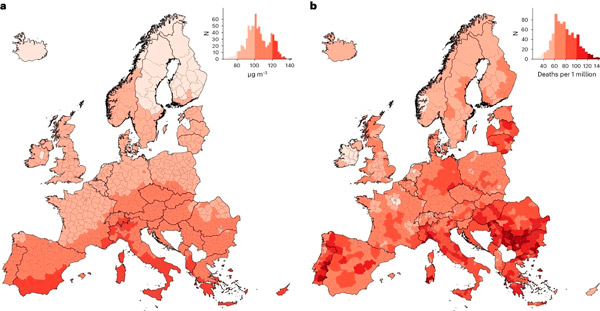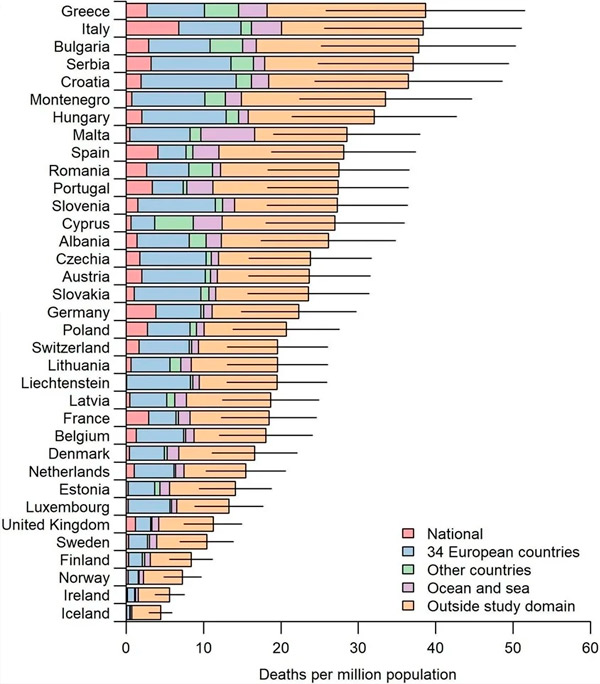Nye publikasjoner
Grenseoverskridende ozonforurensning øker dødeligheten i Europa betydelig
Sist anmeldt: 02.07.2025

Alt iLive-innhold blir gjennomgått med medisin eller faktisk kontrollert for å sikre så mye faktuell nøyaktighet som mulig.
Vi har strenge retningslinjer for innkjøp og kun kobling til anerkjente medieområder, akademiske forskningsinstitusjoner og, når det er mulig, medisinsk peer-evaluerte studier. Merk at tallene i parenteser ([1], [2], etc.) er klikkbare koblinger til disse studiene.
Hvis du føler at noe av innholdet vårt er unøyaktig, utdatert eller ellers tvilsomt, velg det og trykk Ctrl + Enter.

I en fersk studie publisert i tidsskriftet Nature Medicine identifiserte forskere de geografiske kildene til ozonforurensning i luften og estimerte ozonrelaterte dødelighetsrater i Europa.
Bakkenivåozon dannes i troposfæren ved samspillet mellom sollys og klimagasser (GHG-er) som slippes ut fra både naturlige og menneskeskapte kilder, spesielt nitrogenoksider og flyktige organiske forbindelser.
Bakkenært ozon er et svært skadelig luftforurensende stoff. Det er forbundet med mange luftveiskomplikasjoner, inkludert astma, kronisk obstruktiv lungesykdom og lungeinfeksjoner. Dessuten er overdreven ozoneksponering den viktigste årsaken til sykehusinnleggelser og for tidlig død relatert til luftforurensning over hele verden.
Ifølge Det europeiske miljøbyrået er mer enn 95 % av den europeiske befolkningen utsatt for ozonnivåer som overstiger retningslinjene for luftkvalitet fastsatt av Verdens helseorganisasjon (WHO).
Troposfærisk transport av ozon og dets forløpere fra fjerne kilder, også kjent som importert ozon, er den viktigste faktoren for bakkenært ozon. Derfor er det behov for samordnet tiltak mellom land for å effektivt redusere bakkenært ozon og de tilhørende helseeffektene.
I den nåværende studien vurderte forskerne helsekonsekvensene av eksponering for bakkenært ozon i Europa. De kvantifiserte også dødelighetsrater knyttet til både innenlandsk og importert ozon i 813 sammenhengende regioner i 35 europeiske land, som representerer 530 millioner mennesker.

O3-nivåer og tilhørende dødelighet i den varme årstiden (mai–september) 2015–2017.
A. Daglig gjennomsnittlig maksimal 8-timers O3 (µg/m³).
B. Dødelighet (årlige dødsfall per 1 million innbyggere) som kan tilskrives O3.
A, b. Histogrammer viser både fargeforklaringen og antall regioner for hver verdi.
Den gjennomsnittlige ozonkonsentrasjonen ved bakkenivå i europeiske land ble anslått til 101,9 μg/m³. Ozonkonsentrasjonene i sør-europeiske land var høyere enn i nord, noe som kan forklares med det varmere klimaet i denne regionen.
I løpet av de varme årstidene 2015–2017 ble det rapportert 72 årlige dødsfall per million innbyggere. De høyeste dødsratene ble registrert i tett befolkede og sørøsteuropeiske land.
Omtrent 88,3 % av alle ozonrelaterte dødsfall skyldtes eksponering for importert ozon, med et spenn på tvers av landet på 83–100 %. Hemisfæriske kilder var de viktigste bidragsyterne til importert bakkenært ozon, som var ansvarlig for 56,7 % av alle ozonrelaterte dødsfall.
Eksponering for importert ozon produsert av andre europeiske land var ansvarlig for 20,9 % av alle ozonrelaterte dødsfall. Importert ozon fra hav- og marine kilder bidro også til 7,2 % av alle dødsfall i mindre søreuropeiske land.
De mest folkerike og industrialiserte landene var de viktigste bidragsyterne til dødelighet knyttet til importert ozon. Signifikante effekter av ozon med opprinnelse fra Frankrike ble observert på dødeligheten i naboland, inkludert Luxembourg, Sveits, Belgia, Liechtenstein, Spania og Tyskland. Tilsvarende påvirket ozon fra Tyskland dødeligheten betydelig i Luxembourg, Tsjekkia, Nederland, Danmark, Østerrike, Belgia og Polen.

O3-tilskrevet dødelighet fordelt på O3-utslippskilder i 35 europeiske land i 2015–2017. Bare dager da den daglige gjennomsnittlige maksimale 8-timers O3-verdien oversteg 70 μg/m³ ble inkludert i analysen. Horisontale søyler representerer 95 % empirisk konfidensintervall for den totale O3-tilskrivbare dødeligheten (dvs. summen av bidragene fra de fem kildene).
I de sørvestlige landene var effekten av grenseoverskridende ozontransport mindre uttalt. De høyeste dødelighetsratene på grunn av nasjonal ozonproduksjon ble registrert i Spania, Frankrike og Portugal.
En sensitiv analyse som vurderte ozonrelatert dødelighet ved en trygg terskel på 70 µg/m³ viste en tredobling av dødsfallene til 23 årlige dødsfall per million innbyggere i løpet av de varme årstidene 2015–2017.
Den brede geografiske dekningen i den nåværende studien gjorde det mulig for forskerne å bestemme virkningen av bakkenært ozon på den totale dødeligheten på tvers av kontinentet. Den største dødelighetsbyrden i Europa skyldtes hemisfærisk ozon transportert fra andre land. Til sammenligning skyldtes bare en liten andel av dødeligheten ozonproduksjon på nasjonalt nivå.
Ozon som transporteres fra andre europeiske land påvirker også dødeligheten betydelig. Det er observert et betydelig bidrag fra ozonutslipp fra marine kilder til dødelighet i noen kystregioner og små middelhavsland.
Studien fremhever behovet for grenseoverskridende vurdering av forurensningskilder og tilhørende helsekonsekvenser for å håndtere luftforurensning effektivt. Imidlertid er de fleste nåværende tiltakene for å redusere forurensningen fokusert på nasjonalt og regionalt nivå.
Den observerte effekten av marine utslipp på dødelighet understreker behovet for kontrollområder for nitrogenutslipp for å redusere utslipp av nitrogenoksider, noe som har blitt implementert med hell i Nordsjøen og Østersjøen.
Nåværende prognoser indikerer at global oppvarming kan øke ozonnivået ved bakkenivå. I tillegg til å direkte utløse ozonproduksjon, kan global oppvarming også øke utslipp av ozonforløpere, noe som ytterligere kan bidra til de totale ozonkonsentrasjonene i troposfæren. Det er derfor nødvendig å redusere klimaendringene for å forbedre luftkvaliteten og redusere helsekonsekvensene av luftforurensning.
Samlet sett fremhever studiefunnene behovet for nasjonale eller koordinerte paneuropeiske tiltak og globale strategier for å redusere de dødelige effektene av ozoneksponering.
